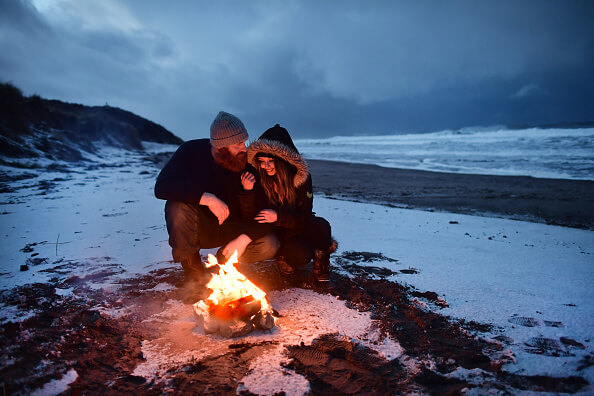Here are a few things to consider when lighting a fire in frigid conditions.
Before you start
Before anything else, pick a space that’s away from anything that might catch fire from stray embers like a tent, tarps, trees, or bushes. Make a fire pit. Clear an area of snow and dig a small hole in the ground then surround it with rocks. If the ground is frozen, you’ll need to build the pit with rocks from the ground up.
It starts with the right spark
If a journey of a thousand miles begins with one step, a good campfire starts with the “right” spark. You can start your fire through a variety of ways; whether it’s from windproof matches, a ferro rod, or even a lighter. Personally, firesteel is a solid option since it never runs out.

Tinder gets it going
Tinder can be flammable stuff like wood shavings, forest lichen, bark from a dead tree (make sure it’s dry), old newspapers or homemade tinder will work fine. Two great DIY hacks to use as tinder are washing machine lint, ideally from cotton-based laundry and, would you believe it, Doritos.
Get the right wood
You need to find the right wood to keep those flames going. The wrong wood could render your efforts useless, and finding firewood in below-zero temperatures is no picnic. By “right” wood, we mean wood that’s dry and not moist.
Avoid sawing the big branches off a living tree since wood from a “live” tree takes longer to ignite or just won’t catch fire due to its high moisture content. The only branches from living trees worth using are the dry, low-hanging ones that break off easily.
Also, the tree you get wood from makes the difference between a roaring fire and a nonexistent one. Use dry wood from Conifer species (Evergreens; trees that keep their leaves year-round and have cones) like Cedar, Pine, Spruce, and Balsam, to start a fire.
Then use wood from Deciduous species (trees that shed their leaves in winter) such as Maple, Oak, or Ironwood to keep a fire going.
Use dead trees
Focus on getting wood from fallen trees; their bark and branches will do the trick. If you can’t find any, you can harvest branches from standing dead trees or cut small dead trees down. How can you tell which trees are dead in winter? Look for trees with their bark gone or peeling off, and no fine branches.
Keep the flames alive
There are numerous ways to build fires. One simple method is to stack kindling in a teepee-like fashion or surround the fire with larger logs in a square shape, while tossing smaller sticks into the fire (the larger logs can burn later).
You’ll need to periodically check the status of your fire throughout the night to ensure it doesn’t burn out or spread. Ideally, this is a task you can share with others in your group so you can all get some rest ahead of the challenges the new day will bring.


